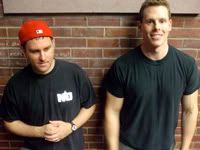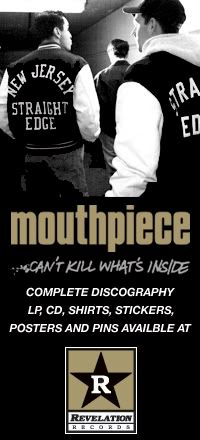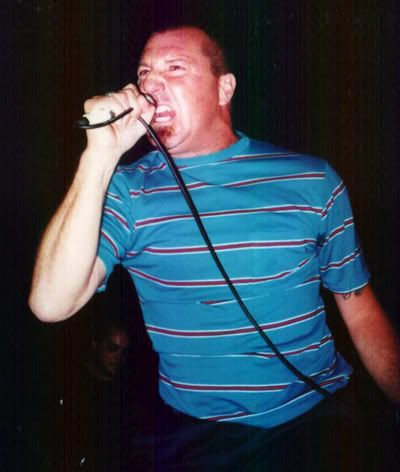
Clifford with BL'AST! in 2001, photo: Fred Hammer
In classic short and sweet style, Clifford delivers more BL'AST! history and answers. Dusted Angel is going into the studio soon to record their LP, so Clifford will be back after that with more. Until then.. -Gordo DCXX
What are your favorite songs off of The Power Of Expression?
Our Explanation and Something Beyond.
By 1985, how had the California scene changed from the turn of the decade? Where did you feel that BL'AST! fit in?
It was getting more metal influenced, with the whole crossover thing. Also, the whole "gang" thing got really heavy within the scene.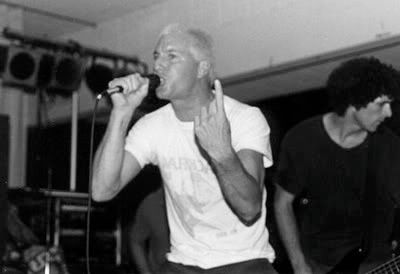
Old style BL'AST! with a bleached out Clifford Dinsmore
What exactly happened with Steve leaving and Kip coming in? What was the difference between the Steve line-up, the 4-piece line up, and the Kip line-up to you? Did you have any idea Kip would end up 20 years later with Alice In Chains?
Steve decided to leave the band, and Kip had sent us a letter asking if we needed a guitar player. C.O.C knew him and gave him a good reference, so we tried him out. He wasn't in the band for long, but we played some of our best shows ever with him, and he wrote a couple of rad songs. I enjoyed all the BL'AST! line-ups. Come to think of it, I do recall Kip mumbling something under his breath, along the lines of..."some day, when I grow up, I'm going to be in a band called Alice In Chains." (ED. Note: Zing!)
There has always been some confusion as to BL'AST!'s ties with the straight edge scene. Some early lyrics have some "straight" themes, i.e. I Don't Need II, but nothing too concrete. Where did the band fit in with the growing SE scene of the later 80s, and what exactly is going on with the sound clip at the end of I Don't Need II on Power?
I was the only "straight-edger" in the band. While I was sitting around pumping iron and listening to Insted, the other dudes were shooting hard drugs into their eyeballs, penises, and labias, and drinking Bacardi 151 out of a beer bong. For that reason, we didn't really fit in with the straight edge scene. I recall that the clip at the end of I Don't Need II was that of an ice cold 16 ouncer of delightfully refreshening Ranier Ale being cracked open. 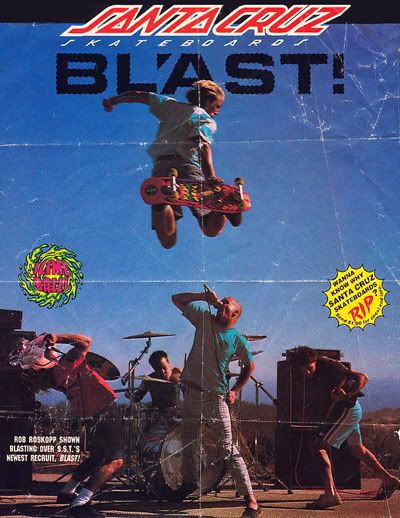
BL'AST! Santa Cruz Skateboards ad that appeared in Rip Magazine
What were some of the perks of the Santa Cruz Skate ties? What do you remember about the Roskopp photo session/poster? How did you guys fit into the skate scene of the time and how did that fit into the whole image/vibe of BL'AST?
It was rad being hooked up with Santa Cruz, and they would give us tons of shit to give away. Near riots would constantly ensue when we would throw out a new "Slasher" or Roskopp model into the crowd. I remember throwing a "Slasher" board into the audience at The Rat in Boston before Time To Think/Surf And Destroy, and when the 2 songs ended, there was still a huge dog-pile of people fighting over it! I thought the giant, meathead bouncers were going to kill us!
The Roskopp photo session was hilarious! He broke his board on the practice run, and Tim Pumarta had to drive back to NHS during rush-hour traffic to grab a couple more. Meanwhile we were standing around with all of our equipment set up in the middle of the street. BL'AST! was four skaters and a surfer...it's what we and all of our friends were all about.
How did BL'AST! develop or change after Power, and how did the It's In My Blood songs develop? Did anything with the band change, or did it feel like you just kept on truckin'? Was SST exactly where you wanted to end up?
BL'AST! was always changing and getting more hectic. We were dedicated to musical expansion, and breaking the norm. During that golden era, SST was the place to be...my, how things have changed. 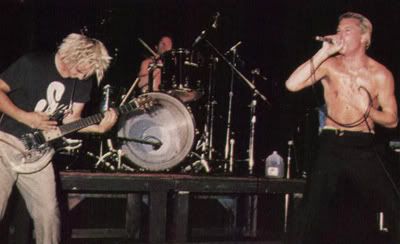
BL'AST! pic stolen from Thrash Metal Magazine, 1988
Sunday, February 28, 2010
Clifford Dinsmore - BL'AST! part III
Thursday, February 25, 2010
Anthony Pappalardo on Amenity "You Can't Stop The Show"

I first met Mike Down 19 years ago when my band Mouthpiece was playing the Che Cafe in San Diego, California. We loosely kept in touch over the next five years or so and then our communication faded. What I remembered most about Mike was his passion for hardcore and music in general. Mike could talk for hours and hours about the bands he played in, the shows he went to, the bands he loved, the records that inspired him, his label, the Chula Vista kids, etc., it all meant the world to him and he expressed it in a way that so few ever could. Mike was also all about making things happen. Whether it was putting out records, touring or printing up t shirts, posters and stickers, Mike was definitely a doer and I respected him quite a bit for that.
Within the past couple years, around the release of the Radio Silence book and the start of Double Cross, I re-connected with Mike. We went back and forth through emails for awhile and eventually last week we started talking on the phone. Just as I had remembered him from 19 years ago, he still had that same passion, enthusiasm and sincerity for hardcore. He pitched the idea to me about debuting this new Amenity song on DCXX and before I even heard the first note, I was sold.
Just a little background on the track, what you're hearing is Amenity's Mike Down on vocals, Tim Gonzales on guitar and guest vocals by Quicksand's Sergio Vega as well as San Diego native, Hajj Daud who does the spoken word piece. There's no drums, no bass, just four guys speaking and playing from the heart.
As for what Mike's up to now, he's managing and developing a band of kids, 14-17 years old from NYC called BYS. BYS have been hosting an all-ages matinee series called "Better Together" at The Studio at Webster Hall and have an EP to be released late spring 2010. Check them out at BYS-CREW.com As for Sergio, he's now playing with the Deftones and they have a new record called "Diamond Eyes" due out May 18th, 2010.
Gravity and Down Side (Mike's label) will be releasing all the new Amenity tracks, as well as the entire back catalog and some unreleased stuff, that has long been out of print. For Lyrics and Info check out Amenity at http://myspace.com/amenitysd.
Ok, enough of what I have to say, now dig into what Radio Silence's Anthony Pappalardo has to say about Mike and Amenity. -Tim DCXX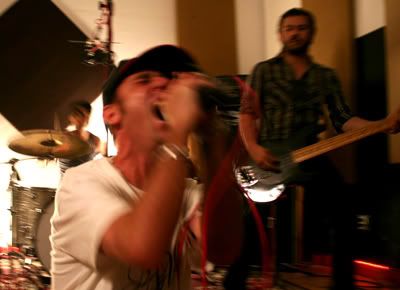
Mike with Amenity on local San Diego radio station 94.9, July 2009, Photo: Dan Rawe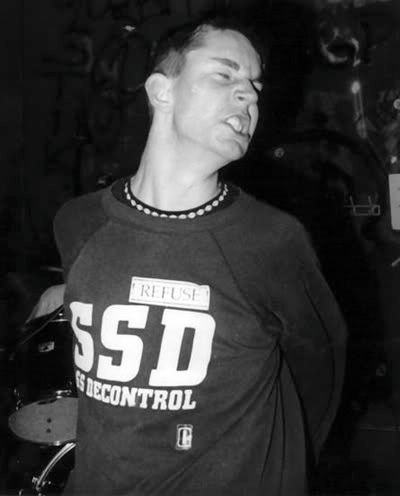
Mike with Amenity at Gilman St, Berkeley, CA, 1988
Let me outline my nightmare scenario: you're hanging out with someone who picks your brain for a minute and realizes that you have a connection to hardcore. Seconds later you're going back and forth about shows, favorite records, t-shirts once owned and lent to ex-girlfriends and fight stories that never actually happened. Suddenly you're in a familiar place, both you and new guy ordered the same zines, mail ordered the same 7"s and have a grip of mutual friends. You have that wide-eyed glow of a sixteen year old until dude utters this one: "Man…those were the days, before the internet, it's so fucking easy for these kids today to just go to a chat room and learn about moshing."
The only thing lacking on the interwideweb is context. I love having access to every mp3 of every record and demo I can think to search for. The comedy is seeing Abused mp3s two entries below links to a Poison The Well CD and a Cock Sparrer live set with some cut and paste blurbs about said bands.
What differentiates these bands from any other overly compressed file @blogspot.com? Is a blog with punk/hardcore links any different than a site with unreleased Dangerous Toys and Bullet Boys tracks?
I'll stick my neck out and say that no one's life was changed by Jackal or Bang Tango. They might have catchy pop metal tunes or make doing yard work go by a little easier but at the end of the day it's pop music made by dudes who wanted to get pussy and blow magic marker rails. It was easy for Mr. Cobain's flannel to wipe these gentlemen out because they weren't ever relevant and they're gone now or relegated to Casino tours.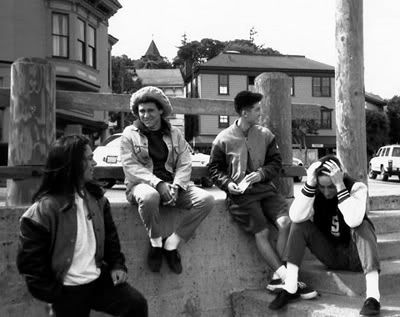
Amenity, Berkeley CA, 1989, Photo: Robb Osborne
With everything ripped and uploaded we now have a living archive of blood, sweat, emotion and feeling available to us all. EBay prices and message board fetishes overshadow reality. In the pre-blogsphere, context was everything. Everyone from that world has a connection to a local band that they saw every weekend, the band that never recorded but were amazing live, the band that recorded their one demo with a chain smoking hard rocker who didn't understand why the guitar player wasn't soloing. It's nice to get a little back story...it grounds things and makes you appreciate their existence so much more.
My early days of shopping for punk and hardcore records in the suburbs of Boston were simple. First I sought out the heavy hitters. I'd run to the B section for Black Flag, the M section for Minor Threat, skip to the Local section hoping a copy of Get It Away slipped by the clerk and could be scooped for a few bucks, and then I'd study the records that I wasn't familiar with. Hardcore records offered plenty of context clues. You could look at the singer's shirt, skim the thanks list and size up the fonts used on the record and quickly decide if said band was worth a few bucks. Sometimes you end up with a perfectly pedestrian predictable record like the Inner Strength 7" and other times there's something interesting enough about the look and vibe of the record for you to take a chance.
Later on in my mailorder and bin scouring days, Amenity immediately struck me with the unique look of their records. They didn't come off as a straight edge band, a punk band, a by-the-numbers hardcore band or as anything other than Amenity. Their name sounded unique, they were from Chula Vista, CA which sounded exotic and ubiquitous to me. Their records weren't packed with macho live shots or crew photos that I could immediately draw a conclusion from. They used contrasty, almost primitive Mayan sun-worshipping images which seemed to be a nod to their Californian lifestyle. Their records were printed on textured paper sometimes featuring wood cut print artwork that referenced Mexican Revolutionary protest posters. Once you cozied up and let the needle lock into the grooves of their records you knew that they were ushering a sound that was rooted in the tradition of hardcore but would eventually evolve into something unique that reflected each member's personality.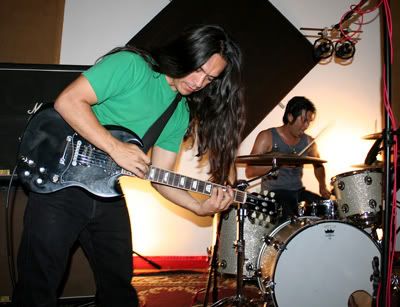
Tim Gonzales with Amenity at the 94.9 radio show, July 2009, Photo: Dan Rawe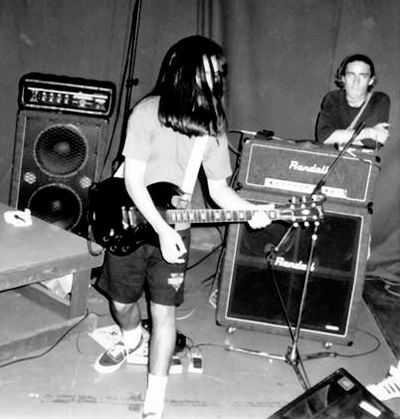
Tim with Amenity 1989
I first met Tim Gonzales, Amenity's guitar player, in San Diego in the late 1990s. My band was playing a show and I made a point of wearing a kelly green off-set screened Amenity shirt given to me by my former band mate Ryan Murphy. His old band Undertow had played with Amenity several times. He didn't understand how blown away I was that he had such an incredible Amenity shirt. I had never even seen the design before he showed it to me in 1994 in a basement apartment in Allston, Mass. I figured that since we were playing in San Diego near Amenity's home, someone would appreciate me wearing that shirt and soon enough I was rapping out with Tim about SS Decontrol, DYS and other bands from where I was from.
When Nathan and I began to compile content for Radio Silence, I reached out to Mike Down via his MySpace page. After Amenity's dissolution in the early 1990s Mike played in a few rock bands and toured with Rage Against The Machine, but the majority of his time had been spent in the hip hop scene, even recording a track with Sean Paul. Any reservations I may have had about Mike's current relationship to his past in hardcore dissipated upon seeing the bold Down Side logo featured on his MySpace page which was once so prominent on Amenity and Forced Down releases.
A few days later I was standing in front of the Diesel store on the Upper East Side a block from my work and my phone rang. I was thrust into a whirlwind conversation with Mike Down about Amenity, Forced Down, Gravity Records, Chula Vista, Unbroken and everything he was now doing. There was an undeniable passion in his voice and the thing that struck me immediately was that this passion permeated every topic of the conversation. Every anecdote or detail was delivered with a genuine immediacy and energy that let me know that he understood the project and what he could contribute personally.
Sergio with Amenity at the 94.9 San Diego radio show, Photo: Dan Rawe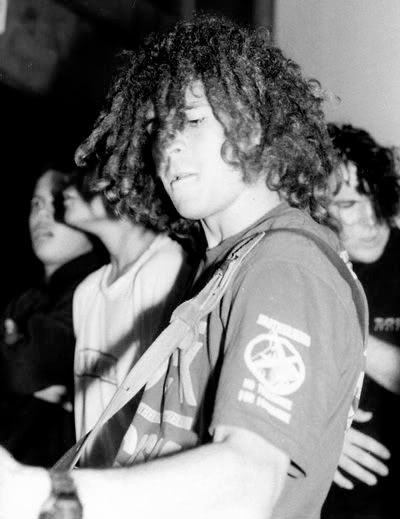
Sergio with Amenity, 1989
I learned that Mike made both San Diego and New York City his home and we soon met up at Von Bar on Elizabeth and Bowery, pissing distance from the former site of CBGB. We spent hours over the next few weeks meeting up here and there and discussing the brilliant minutia of hardcore. Every time I met up with Mike he'd introduce me to a minimum of fifteen new people; people he'd bump into on the street, people we'd see at clubs, people we'd meet up with or just old friends tending bar.
The thing that struck me about this was that none of these people were handshake friends who would cough and forget your name. Mike's people were genuine, they shared his passion and drive. It felt as if once you had crossed into Mike's world that a switch was flipped and you were really living. It took me by surprise when he casually told me that Amenity was planning on getting back together to play shows and most importantly, record new music.
The biggest thing I had taken from Mike in our time discussing San Diego and Amenity specifically was that Amenity really acted as a bridge in their scene. While they were completely active and driven in the 1980s, what they contributed to the 1990s really defined them. One thing that Mike Down embodies is the idea that D.I.Y. isn't an excuse to skate by. Amenity records didn't have the charming rushed look of early hardcore records. The design was sophisticated. Touching on the Revolution Summer Dischord aesthetic, the records were silkscreened and stamped by hand on textured paper. The early 1990s sent hardcore into two trajectories: the slicker more professional route, and the very personal hand screened path. When you look at two copies of the This Is Our Struggle 7" side by side you immediately notice that the stamps are placed differently on the inserts, that there's a personal touch to each record. It was nice to know that some kid just like myself tucked in a burb thousands of miles away had touched and created the record I was now playing.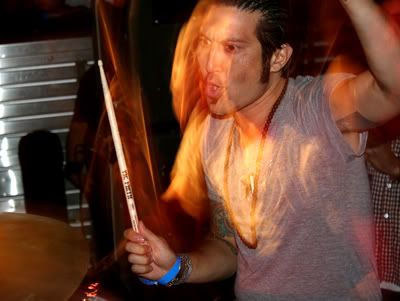
Barry with Amenity at the Radio Silence Release party San Diego, CA, Photo: Dan Rawe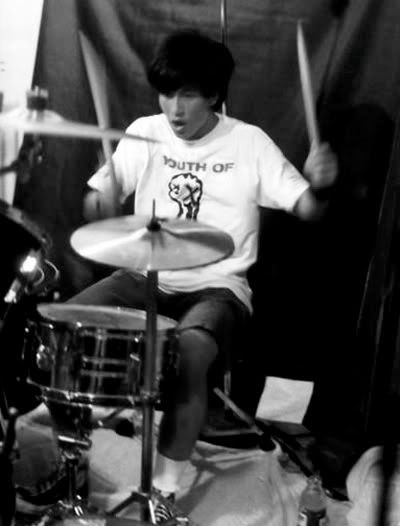
Barry with Amenity 1988
From our first conversation, I knew that Amenity's reformation wasn't a nostalgia trip and was solely motivated by a desire to create and pay tribute to San Diego and Chula Vista. Mike's conversations never touched on Amenity's past but rather the new songs they were writing, the shows they'd soon be playing, and most importantly, the new faces that would soon see them play. Mike never mentioned "the old gang" that was going to come out for their shows, that was a given. It was all about the younger generation that had reached out to him and were inspired by Amenity.
A few months later I found myself escaping the cold snap of a New York winter and laying on the grass of a beautiful public park in San Diego overlooking the bay. In a few hours Amenity would transform a raw warehouse space, complete with saw blades and drilling equipment, into an all ages venue because they had to. They weren't going to play unless it was for everyone so they took it upon themselves to find a way to do it.
From the first note I was struck by the intensity and enthusiasm of the crowd. There was no critique of the appearances or back stories of the four men on stage; only kids ages 13 to 43 screaming every word of their struggle until they were hoarse. One of the highlights of the show was watching Amenity perform their newest track Shine, not only because it was a great song and featured Matt Anderson's signature scream, but also because the younger kids there knew this song and sang it without the urgency of any other track.
Amenity's latest chapter is more deliberate, more conscious and aware that they're moving forward into the past. You Can't Stop The Show is a journey of a band beginning at its rawest components, just a guitar and vocals somewhere in a bedroom thinking about their mission and how they'll execute their plan. This path is now illustrated over 20 years after the band's inception and it's Mike and Tim laying it down again with some help from Sergio Vega and Haji Daud who contributed a poem that captures the spirit and heart of Amenity.
You Can't Stop The Show. - Anthony Pappalardo
Can't Stop The Show by TimDCXX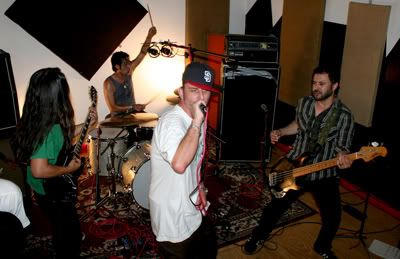
Amenity at the 94.9 radio show, San Diego, CA, July 2009, Photo: Dan Rawe
Wednesday, February 24, 2010
Agnostic Front - Victim In Pain - 25 Year Anniversary Show

Agnostic Front has changed the face of music throughout their 25-year-long career and the Victim In Pain and United Blood records started it all. In celebration of these eminent re-releases, Agnostic Front will pay homage to where it all began with a headlining show on February 26th in NYC. Showcasing at The Bell House in Brooklyn, Agnostic Front will have their original 1984 lineup in tow – Roger Miret, Vinny Stigma, Rob Kabula, and Dave Jones. “We haven’t played together since ’84, this is the CLASSIC lineup together again doing vintage AF songs and some classics. We couldn’t be more excited to do this!” said vocalist Roger Miret. 
Tuesday, February 23, 2010
Howie Abrams - In-Effect Records part IV

24-7 Spyz at City Gardens, Trenton, NJ, Photo: Ken Salerno
NYHC legend Howie Abrams has brought us a great interview. If you missed out, check the archives from last month for the first 3 installments for plenty of talk about CB's, AF, In-Effect, and more. Here is the fourth and final part. Big thanks to Howie! -Gordo DCXX
Hardcore obviously was different in 1991 than it had been in 1986. In your eyes, what changed in NY for both good and bad, and where were you at as a "fan" by that point? What are stand out memories for you during that time period?
In '86, I think the hardcore scene still felt relatively similar to the scene that had originally been created. It had gotten big, but not so big that the essence was completely lost. Not everyone got along, but whatever fighting took place was usually HC kids versus an outsider.
That said - the divisions had begun to surface and unfortunately grew and splintered the whole thing as time went on. There were numerous scenes within the scene now. "United and Strong" became divided and snobby. You almost had to redefine yourself based on what faction of the scene you felt you belonged to.
There were the Hardcore/Metal crossover kids, the straight edge kids, the alterna-core kids...it was no longer a bunch of disenfranchised youth with different haircuts in the same room, representing the same movement. It was as if the Army, Navy, Air Force and Marines all decided that they could not fight side by side, but needed to prove that THEY were the REAL ones.
Lou Koller with Sick Of It All, Photo: Ken Salerno
Also, these developments within the HC scene ran parallel to the rise in popularity of hip-hop culture in NY. As time went on, the scene took on this real street/thug vibe and while a lot of the more street types were genuinely into hardcore, many of them weren't particularly dedicated to it and had a short fuse. With an aggressive scene such as there was in NYC, you can imagine what went on at some of the shows as time went on. It got ugly and things started to go downhill. CBGB quit doing matinees and the hub for the scene was gone.
Many people did things to try to revive what once was and there were always shows somewhere, but it was never the same. For the most part, they were just shows...not a gathering of a community, although I know there are people out there, probably younger kids, who are going to say that that's not true. Fine. Also, major labels were now on to hardcore and some of the bands started to get signed. That set off a chain reaction of a lot of "fake" hardcore bands popping up because everyone thought they would get a big record deal by playing hardcore.
For all of the criticism I just outlined, hardcore most definitely changed my life in a very positive way. There have been many lessons; both good and band and some of the very best experiences of my life have been related to hardcore. For all of this, I am eternally grateful and more importantly, for the great people and bands I can now call my friends. I feel as if there's more to offer on this topic, but the bottom line is that as you move further and further away from anything that once had specific characteristics, you can rest assured that they will change for better or for worse with time.
There are definitely some GREAT bands that have formed since those days, but the community aspect of hardcore will never...CAN never be the same ever again. It's just the way the world works. Enjoy what you have while you have it, because it won't be there forever.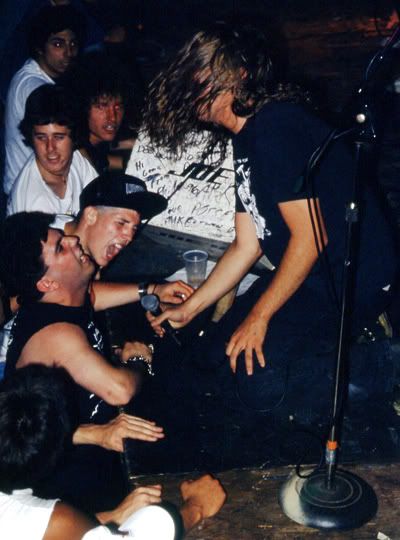
Ludichrist at City Gardens, Trenton, NJ, Photo: Ken Salerno
What were you up to during the 90s in the music scene and with Roadrunner? Who were your favorite bands to work with, and how do you characterize that time period for the NYHC scene?
The 90s definitely represented a change for Hardcore, especially here in NY. Metal was now a huge part of the NYHC sound, which didn't bother me all that much. However, it was the complete change in the vibe and overall attitude that made me feel less a part of what was going on. The original essence of "us against the world" had faded away and the scene became so splintered. Also, a lot of bands became focused on monetary success via Hardcore, to the point that some even operated as if their sole purpose for making and playing music was to get "big."
Even throughout my time at In-Effect, we never made decisions based on stature or how much money could be made. It was way more about getting a fair shake and reaching as many kids as possible. Ultimately, it was as if the label and our bands were still fighting Mike Tyson with one arm tied behind our back on a daily basis. Now, huge record labels were aware of hardcore and it made many people re-think the whole thing. No major label publicist at the time gave two shits about a kid's fanzine or college radio show. Nor were they going to take out a co-op ad for a show at a VFW hall.
These labels signed these bands to cash in on something they thought was commercially viable and a lot of bands fell for it. They actually believed hardcore was going to get onto the radio. Boy, were they wrong. I don't have anything against the bands who jumped into that whole thing...that was their prerogative. I guess I was just surprised by how many smart kids from the scene drank the Kool-Aid.
As for the violence that became more of an issue in NY - sure it got pretty ugly and you had to concern yourself with kids who had a whole different idea of what the show experience was about, but hardcore is aggressive to begin with and the dancing is physical and violent. What the fuck did people expect to happen when it became as trendy as it did???
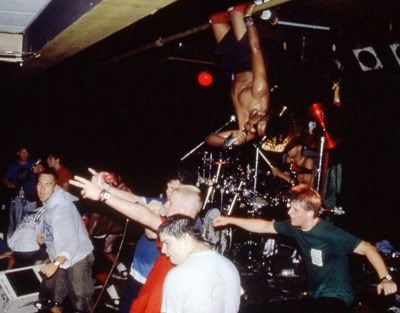
24-7 Spyz stage mayhem at City Gardens, Photo: Ken Salerno
Just because there were a lot of independent thinkers around, didn't mean that some of them weren't fucked up kids - and many were. I don't condone bringing weapons to a hardcore show...it makes no sense to me whatsoever, but kids bringing box-cutters and guns to school makes no sense either...on paper. These shows were a legitimate, volatile gathering of the tribes and you can't expect that many people from such diverse ethnic backgrounds and economic situations to regularly come together in that type of environment and all be on the same page.
The violence definitely fucked things up for a lot of kids and made them lose interest, but to me that's a bit of a cop out. There's violence in the world every minute of every day and you can't just run and hide. Imagine what NYC would be like if we just let the "bad guys" win uncontested and did nothing about the problems. Ultimately, a lot of the problems sorted themselves out and sadly, there were a lot fewer kids around to see that change.
As for Roadrunner, overall it was a really good experience. The owner really liked what I had done with In-Effect and asked me to come there and do something similar. He originally wanted me to launch another imprint, but I actually talked him out of it. At that time Roadrunner was underground as fuck with all of the death metal bands they had and I saw no reason why RR could not just expand by also working with hardcore bands. I signed a number of pretty important bands there such as Madball (for the second time), Shelter, VOD, Black Train Jack, Dog Eat Dog and others. I was also behind the marketing of some of the other RR bands like Sepultura, Type O Negative, Biohazard, Front Line Assembly...
Hardcore actually meant a lot less to me by that time in terms of purity. The scene had become so impure anyway, so I just chose to focus on the bands which I thought were great and also had the right attitude. For instance, a lot of people shit on Dog Eat Dog and tried to reduce them to being some sort of Leeway rip-off, but when I signed them, they only played HXC shows, were incredibly respectful and supportive of NYHC and were doing things the right way. Eventually, they blew up basically as a pop group in Europe and for all of us, including the band, it seemed to come from out of nowhere. Very often, that's how things happen. They were playing the right music at the right time and the elusive luck and timing you hope for fell into place for them. In the end, a lot of cats were jealous of them due to their success and all the early shit-talkers were begging to open up for them overseas. Fuck those hypocrites!
I'm very proud of what I accomplished there and for me, Madball is a great example of something I had a part in that went well for all involved. I've known Freddy since he was 8 or 9 years old, when he would come up from Florida and tour with AF. I put out the Ball Of Destruction 7" when he was 12, but to see him become one of the most undeniable front-men in the history of hardcore and to watch him come into his own as a person was and continues to be really gratifying. Those guys trusted me and worked hard and overcame a lot to get to where they've gotten. To this day, they're one of the only bands that can still get me on the dance floor and incite me to lose it!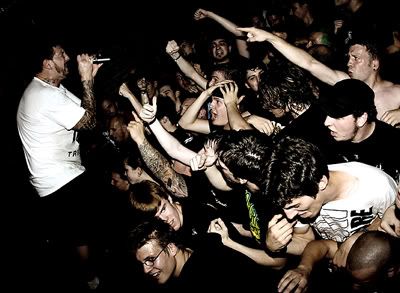
Freddy with Madball, 2007, Photo: Face The Show
The NYHC scene lost some legends during that time, notably Chuck Valle and Raybeez. How did their deaths impact you, and what was it like to see so many people from the NYHC scene come together in the wake of those events?
It's always sad when you lose someone, but the saddest is when it's someone young who passes. Chuck Valle's death hit me particularly hard because if you'd met him even once, let alone really knew him, you were well aware of what an incredible individual he was. Talented as can be and just a great, live and let live kind of guy. The fact that he lost his life and his future as a result of an act of senseless violence still makes me feel sick. As for Raybeez, I honestly didn't know him well, but his contribution to the scene in NY is immeasurable. Then there were the characters like Big Charlie, Frenchie, etc. Simply put - sad.
It always made me proud when the scene would rally around one of its own. Whether it was Roger Miret or Pete Koller's legal issues or especially when we lost someone from the NYHC family. Hell - not many "real" families come together the way the HXC community did to assist the families of those we lost along the way. One of the best things about the hardcore scene as far as I'm concerned. That's the unity everyone was striving for and it was never more evident than when one of "us" was in need. Rest In Power to all who have moved on.
Pete Koller with Sick Of It All, Photo: Ken Salerno
The slow death and ultimate demise of CBGB's had to have given you something to reflect about. What were your best memories of the club, how do you feel about the way it went out, and how will you remember it?
For me, the death of CBGB was tremendously significant. Not the death of hardcore at CBGB, but the loss of the club itself due to those greedy motherfuckers at the BRC who own the building the club was housed in. What sucks is that the BRC does a lot of good things in the community, but they just wanted Hilly out of there and eventually got what they wanted. It's a fucking John Varvatos store now and I get pissed off every time I pass 315 Bowery (makes spitting sound).
For better or for worse, CBGB was the place that will always be looked at as the home of the NYHC scene. Sure there were previous homes like A7, but very few people got to experience that. CB's was THE place and that's hard to disagree with. So many kids' lives changed as a result of that place, including mine. There cannot be a "scene" without a venue for it to thrive in and CBGB was that venue when it came to NYHC. It was the Madison Square Garden of hardcore for that matter.
Wherever you were from, no matter how great your local scene was, CBGB was the mecca and every band treated their shows there as special events. Trying to highlight a favorite moment or show there would be impossible. Every hardcore band I love(d) played their best shows at CBGB. I miss it...even down to its disgusting bathrooms.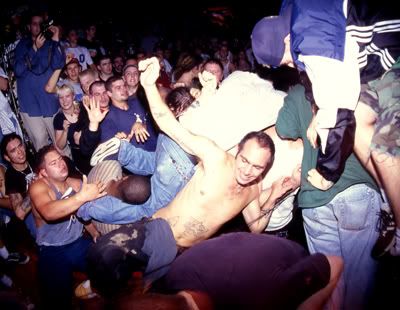
Killing Time at CBGB, NYC, Photo: Ken Salerno
What do you think about the current state of hardcore? Many would argue you can have the best of both worlds, as many old bands have reunited and are playing out, and many young bands have carried the torch of traditional, classic styles as well, and have pushed the envelope for HC and metal. Any thoughts? Where do you fit in with all of this?
I'm not even sure of what to say about the current state of hardcore. It's fun to see some of the old bands get back together to throw down, as well as some of the older bands who never left. I saw the Cro-Mags (John, Mackie, Craig Setari and A.J. Novello) in December and they killed it, but it really has nothing to with the current state of HXC or what the HXC scene will look like in the future. People can argue the point until they're blue in the face, but there is no scene that exists today that even faintly resembles the hardcore scene I remember.
Sure there are still some DIY ethics out there and there are some bands who play $5 or $7 shows in "unorthodox" venues but it's just not the same. A scene requires a lot of elements to be in place and working all at once and I don't see that anywhere. I suppose that can change and hopefully it will, but I won't be holding my breath. There can only be one "first time" and only so many times there can be a so-called resurgence.
I suppose you could say hardcore jumped the shark. Doesn't mean I won't always love it and my experience with it. It also doesn't mean I won't continue to go see the older bands when they come out of the woodwork to play. I just highly doubt there will ever be a new, yet to exist hardcore band that will move me in any meaningful way. That said - much respect to the bands trying to keep the spirit alive, including those who might be in a basement or garage somewhere rehearsing for the first time. Go for yours.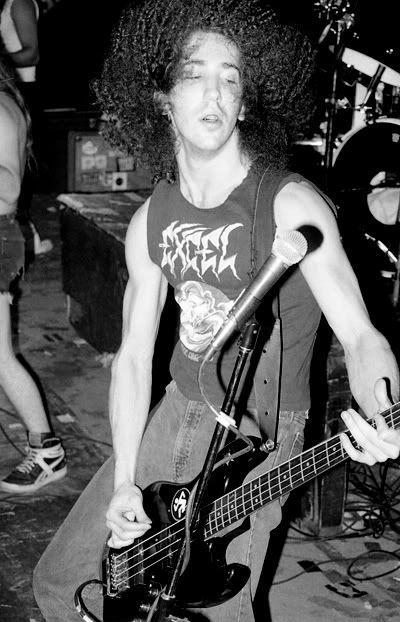
Nuclear Assault at City Gardens, Trenton, NJ, Photo: Ken Salerno
Monday, February 22, 2010
What one hardcore/punk album has stood the test of time for you?
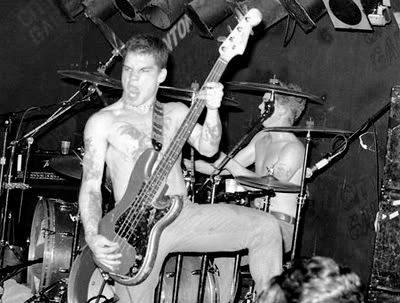
Harley delivers some Hard Times at City Gardens, Trenton NJ, Photo: Ken Salerno
Harley Flanagan - Cro-Mags
Bad Brains Roir cassette, Ace Of Spades, Master Of Reality, any old Minor Threat before the one with the sheep on the cover, Jealous Again, first Circle Jerks album, Hear Nothing See Nothing Say Nothing, Cockney Rejects...a lot of great stuff that came out around that time...I can't narrow it down to one. I tried to bring elements of all of these things and more into the stuff I started writing. I don't know if I succeeded but these were some of the influences and inspirations. I also liked a lot of DC and west coast stuff, Void was off the hook. There was a lotta great stuff. That first Scream album was sick. Of course there were a lot more. In the beginning it was the Sex Pistols, The Damned, The Clash, The Ramones, Dead Boys...that's what set it off for me as far as punk and then hardcore. But..anyway, that was the 70s.
Even shows like Siouxsie And The Banshees and all that old punk shit like the Buzzcocks...I mean it wasn't hardcore or anything, but there was a lot of great shit happening in those days. I saw a lot of great shows like that at the Paladium and at Irving Plaza, never mind all the little punk gigs at Max's and CB's back in the OOOLD days with all the little hardcore gigs at A7 and all the other great places.
Check out my new book coming out - it talks about all of it.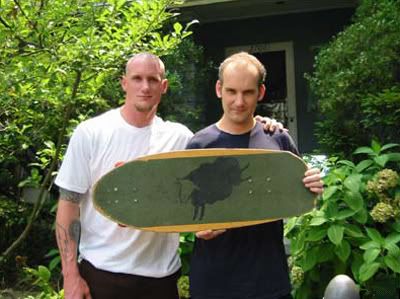
Mike and Ian with the Minor Threat skateboard
Mike Vallely - Professional Skateboarder
I have to go with the first Minor Threat EP. That record just screams out above the rest with everything I've ever associated with hardcore music: the DIY ethos, the energy and power of the music, and the urgency and passion of the lyrics. I can't play that record without getting fired up.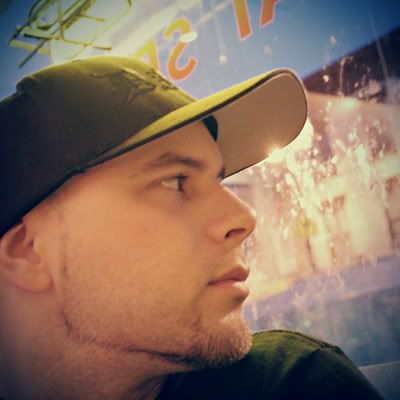
A deep thinking Justin Guavin, Photo courtesy of: Guav
Guav - Conviction Fanzine / Records
In 1986 I was 14 years old living in Ithaca, NY and I knew that it didn't get much harder than Mötley Crüe's "Shout At The Devil." Their song "Red Hot" was pretty much the fastest song anyone could humanly play, and "Bastard"—that song is just MEAN. I was convinced that that was the pinnacle of hard music.
Flipping through the radio late one night when I should have been sleeping, I came across a radio show from Ithaca College called The Sound And The Fury, and it was playing the most atrocious, discordant garbage that I had ever heard. And for some reason I couldn't stop listening to it. It was terrible.
I grabbed my tape recorder and held it up to the radio and taped 90 minutes of the radio show that way. And I listened to that tape over and over again. And then some more. I didn't want to like it, because I thought if I liked punk, I'd have to be a punk rocker—and I wanted to be a metal dude.
But it had gotten its hooks into me and once I figured out when the show was, I'd stay up and tape it like that. The only problem was, to save space on the tape and get the most music onto it, I'd pause the recorder in between songs when the DJ was talking, so I ended up with piles of tapes full of bands that I loved and had no idea what their names were. But there were a handful of songs that really stuck out for me. I somehow learned that my favorite song, "Sailin On," was by a band called the Bad Brains.
Later that year I was visiting my grandfather down in NYC and he gave me some money to go to Tower Records, and one of the records I bought was Bad Brains "Rock For Light." I ran back to his apartment and listened to the record, and was pleased to find out that two of the other songs that were my favorites from my unlabeled tapes were also the Bad Brains, from that record. Jackpot!
And that's pretty much all I listened to for a month. I had never heard anything so urgent, frantic and yet so tight and melodic as the Bad Brains. And to this day, that record has stood the test of time for me and every time I play it it's like I'm 14 and hearing it for the first time all over again. I'm always blown away by it.
A close second place, both for it's musical longevity and personal impact on my life, would go to Gorilla Biscuits, "Start Today."
Sunday, February 21, 2010
Effort Fanzine
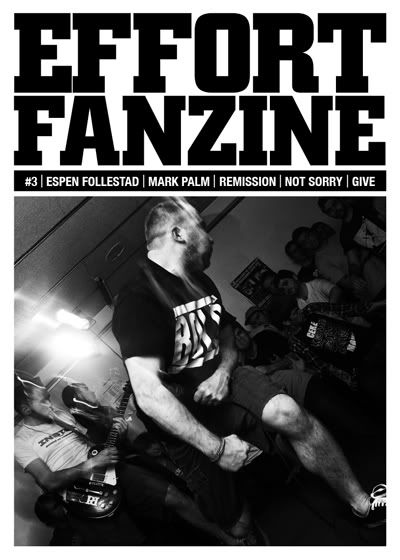
Effort Fanzine issue 3
I love printed fanzines and to be quite honest with you, in some ways I wish Double Cross was a physical, hand held, printed fanzine, but the truth of the matter is that we do what is convenient and works best for us, which happens to be the online format. Hopefully some how at some point, you will see Double Cross in some sort of printed format because I know that is a definite goal for us. In the meantime, if you want to see an example of a great printed hardcore fanzine, look no further than Effort.
Unquestionably and easily Effort Fanzine is one of, if not THE best fanzine I have seen in many, many years. These guys cover all the bases; great design, awesome photos, honest reviews, a perfect mix of old and new hardcore and on top of all that, they've gotten better and better every issue.
Because Effort has stood out to us, we wanted to show support and help bring their work more deserved attention. Meet the guys behind Effort and more importantly, get your hands on an issue ASAP. - Tim DCXX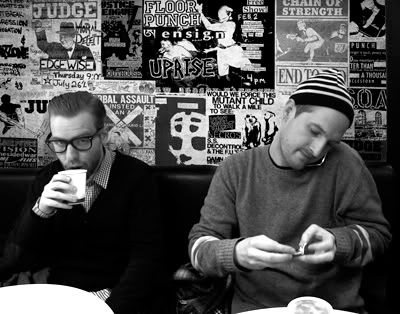
Ulf and Kalle of Effort Fanzine, Photo: Alexander Peters
Tell us about yourselves, how and when you got into hardcore, and what each of you bring to Effort Fanzine?
Ulf: My name is Ulf, I'm the youngster of the two of us, at age 21. I got into hardcore in 2002, which means I've missed out on some great bands for sure. I was in 8th grade and was into all kinds of things musically. I always liked Iron Maiden, Metallica and various heavy bands, but I wasn't passionate about it. However, I always had a thing for heavy music.
I grew up in a very small town, where everybody knew each other. So, I knew that there were some kids that were into some kind of crazy music. They were going to shows all the time, and I think they rehearsed in the basement of our school, but I didn't have a clue what kind of music they were playing or what this "hardcore" thing was all about. That changed when the kid next door, who I've been friends with all my life, started going to shows. I got really curious about it, started asking all kinds of stupid questions, and after probably being a real pain in the ass for a while, he let me tag along.
I then found out about this thing called "Straight Edge" which I totally connected with, since I never had any interest in alcohol or drugs. Shortly after, I bought my first electric guitar and started my first hardcore band. After some half assed attempts in my basement for a couple of years, I was asked to play guitar for a band that was starting out, Go For Broke. That's how Kalle and I met each other.
When it comes to Effort fanzine, we both work together on pretty much everything. Kalle does all the layout work, with some input from me, but the rest of it, we do together. We're into the same stuff, so there's never any trouble.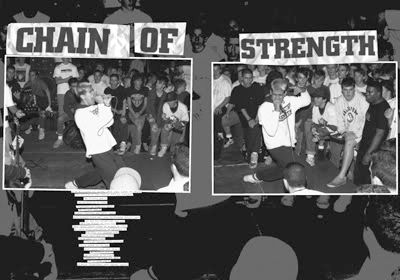
A Chain Of Strength photo spread from Effort Fanzine issue 3
Kalle: My name is Kalle and whenever I'm around Ulf I realize how old I am (27). I got into punk rock at the age of twelve (1994), both the mainstream stuff (Bad Religion, Green Day, Offspring etc) and older stuff like Asta Kask, Stiff Little Fingers and Sex Pistols through an older acquaintance. Growing up in Sweden in the 90's you'd also have to live under a huge rock to miss out on Refused and in a way I guess they're the reason I'm here today.
I also got heavily into Shelter and later on, obviously, Youth Of Today. I fell in love with fanzines pretty quick, and I started my own at the age of 14 (or perhaps 15, can't really remember when we started out). It was complete crap but you have to start somewhere I guess. Me and two friends did three issues, then me and another friend did a fourth one. After that I did a more hardcore related zine called Send In The Clones Fanzine, which lasted four issues. I also do a newsletter/free zine called Get Involved, which is less pretentious than Effort. It's usually something I just throw together whenever there's a cool show.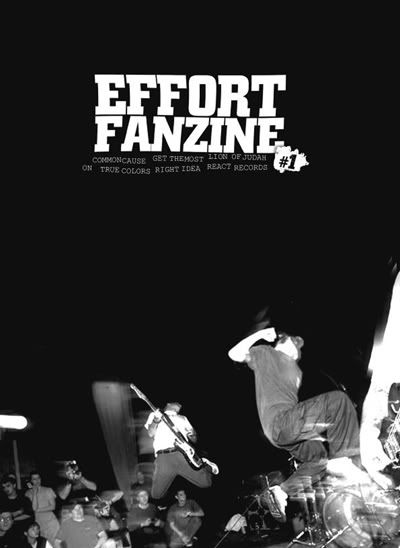
Effort Fanzine issue 1
What was the motivation/inspiration for starting Effort? With the whole internet age, fanzines definitely are not as common as they used to be, so what pushes you to still do it in this classic format?
U: The idea of starting Effort came to us when Go For Broke were planning to do some shows outside of Sweden. We were going to go on tour for a week, with shows in Germany, Poland and Czech Republic. Kalle had previously done Send in the Clones Fanzine, a really good fanzine I might add, and I had done a fanzine called Changes. We both had kind of started working on new issues, but we just got stuck, we had no motivation to really push ourselves to finish our respective fanzines, so we just kind of threw it out there, "Well, why don't we do a fanzine together instead?" It made sense, and with the motivation to have it done in time for the tour, we did the first issue.
What pushes us to keep this going is really that we have a love for what we do. It's really one of those things that's so great about hardcore, if you want to know more about a band or a person that you've encountered, just shoot an email and ask, and you'll probably get an answer. And we do believe that this is more than music, so having the chance to talk to our favorite bands and people that inspire us, and giving them the chance to express themselves in a more relaxed setting than on a stage, it's special to us.
But you're right, fanzines are not as common as they used to be. We've had kids who've come up to us and asked "What's that? A fanzine? What's a fanzine?", and it's so easy to kind of lose faith in current hardcore when that happens. But then again, there we are, with a fanzine and the opportunity to show them what we're doing, and why we're doing it. But it all comes down to that it's what we love to do. Both Kalle and I are persons with creative minds and a need to express our ideas, be it through music or print.
K: To be completely honest, Effort Fanzine was originally the brainchild of Marcus Ericsson (Damage Control) and myself. We had talked about doing a fanzine together for quite some time but nothing ever happened. So basically, two months prior to the tour Ulf was referring to, I just asked Ulf if he would be into it and he was. I knew that he's both a solid dude and that we saw eye to eye on most things hardcore. I don't think either of us ever thought about doing a second issue until we realized how much positive feedback we got. For me, doing the zine online was never an option, I really have a soft spot for a quality printed fanzine and there are few things that can beat that feeling of holding it in your hands.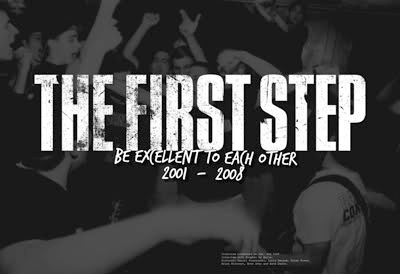
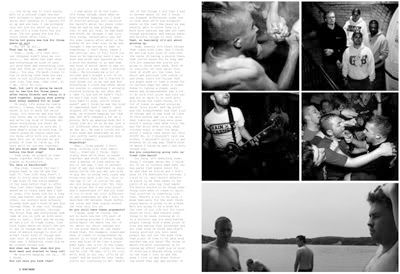
A spread of The First Step from Effort Fanzine issue 2
Give us a brief run down of the first 3 issues, what have been some the highlights in each and what have you been most proud of?
U: Ok, the first issue was put together in two months time for the Go For Broke tour, as I said earlier. We interviewed Get The Most, Right Idea, Aram React!, Lion of Judah, Common Cause and On. It was released in the summer of 2008, 200 printed, and it sold out quite fast. What I'm most stoked about with this issue, is probably that we actually did it. And with a pretty tight deadline as well. We got so many emails from people who were really in to the zine, and I was surprised. Not that I wasn't stoked about the zine myself, but people were really contacting us just to let us know how much they liked it. It gave us inspiration enough to do #2.
With issue #2, we wanted to focus more on in depth interviews, and with both The First Step and Justice calling it quits, we felt like both bands needed some heavy documentation, from how they started, to why it ended. So, with those two pretty massive pieces, especially the TFS one, plus a Mindset interview and a feature about the Radio Silence book (with some In My Eyes and Ten Yard Fight talk as well), we released this 76 page zine on January 31st 2009. We had a release show with Balance, Go For Broke (our last show), Hårda Tider, Loud And Clear, Rhythm To The Madness and True Colors. Justice also did a surprise set, which was something I'd never expected. We printed 200 copies here in Sweden, and React! Records printed 300 overseas. React! still has copies.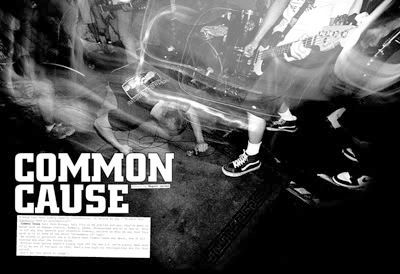
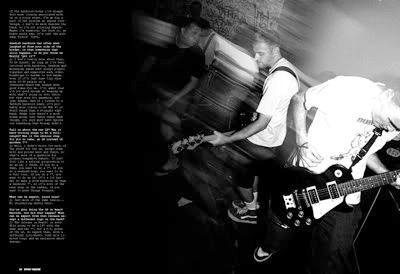
Common Cause spread from Effort Fanzine issue 1
I'm very proud of this issue, in several ways. The TFS piece was mostly Kalle's work, but I'm stoked that we could have such a huge feature on them, really asking everything we wanted, and Stephen seemed to be really into it as well. The Justice piece is special to me, cause that was mostly my thing in #2, and with them playing that surprise set at the release show, my mind was blown. They've played several shows since then, but this was the first one since they had broken up. Really something special.
#3 is going to be released Friday, February 12th, at the Floorpunch show in Linköping. It features interviews with Espen Follestad, Mark Palm, Remission, Give and Not Sorry, plus tons of other stuff. This issue took a year for us to put together, so that's a pretty long time for us, since we started working on the first issue in May 2008, and had the second one released in January 2009. This is my favorite so far though, but I guess that's always how it is. TGhe interviews with Espen and Mark especially turned out really cool, and it gives a nice back story to where they both are in their lives today.
K: After the first issue where we covered pretty much all the bands we were into, doing a second issue got sort of complicated. Mindset were one of the few bands left so we took the opportunity to cover two of the most important bands in modern history; TFS – well, what can I say that hasn't already been said about this band. If I didn't have to hang up the phone there's no doubt in my mind that the 26 page interview could've been almost twice as long. Justice – there are few modern European bands that made such an impact in hardcore. I don't care what people say these days, Justice were solid people and I can't really think of more passionate people. Along with the Espen and Mark interviews those are really the highlights thus far.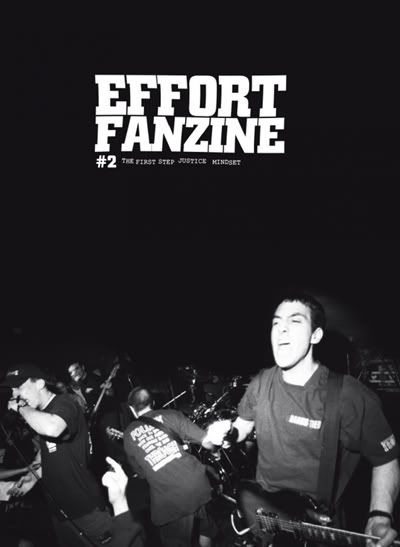
Effort Fanzine issue 2
What goals have you set out to accomplish with Effort and what can we expect for future issues? Any certain interviews you're hoping to get?
U: We never really set any goals. But we both have genuine interest in hardcore...I guess some would call us nerds, or obsessed. So be it, they're probably right. I guess our interest makes Effort good, because we are really interested in the bands we interview, which gives us an opportunity to ask about stuff we wouldn't care about otherwise, and since we do care, we usually get really good answers. We've read so many interviews with the same standard formula, and it gets boring. Not only for the reader, but for the bands or persons interviewed. A mutual interest in the interview is important to us.
About future issues, I'm not sure... I never thought we'd make a second issue to begin with, hell, I originally doubted that we'd finish the first issue. But when the first one was released, we found ourselves making plans for #2 already, and here we are about to release #3, so you never know. When it comes to interviews we're hoping to get, well...we're both massive Chain of Strength fans. I'd love to have a huge, in depth Chain piece in the next Effort. It's no coincidence that the first Effort shirt design was green and black ink printed on a white shirt. Sure, we want to focus on current hardcore, but for Chain, we'd make an exception. I'd be really interested in hearing their perspective on their band. And well, every fanzine makers dream, Mike Judge.
K: There are a few bands that I'd love to interview, one being Praise. I also feel that both Common Cause and Mindset have come a long way since our interviews in #1 and I feel that it could be interesting doing a follow-up interview. I also have high hopes for Peace.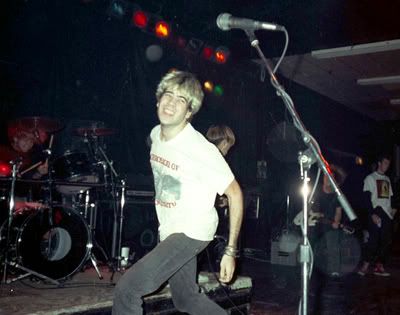
Dag Nasty photo that appears in Effort Fanzine issue 3, Photo: Phillip Fuller
What five fanzines of the past and present are your favorites and why?
U: Can't say I'm that good at keeping up with current fanzines, not good enough to make lists anyway. However, spending a lot of time on tour, I tend to buy a lot of fanzines to read in the van. My current favorites include Sight Beyond Sight, don't know if a new issue is in the works but that first one was amazing. Wake Up And Live out of Portugal keeps putting out quality stuff. I always enjoy reading Soulcity, by Marcus Damage Control. I Drink Milk Fanzine from Hungary is pretty sweet as well. As for past zines, Schism, Boiling Point, Open Your Eyes... Let's just say that the classics have really made an impact on what we're doing today with Effort.
K: I Drink Milk and Heat are two fanzines that I think stand out today. They're my favorite ones, another one is Powered Fanzine which is rather short but then again it's free. Looking back I think of [besides the above mentioned classics]: Impact, Start Today, Best Of Times, Extra Life and Town of Hardcore as quality fanzines. I can't even think of five fanzines today that I will consider classic in a few years.
Five favorite bands of all time and five favorite current bands and why?
U: Youth of Today
Bad Brains
Cro-Mags
Chain of Strength
Minor Threat
No surprises there, but I guess there's a reason for that. Youth of Today is my favorite band, period. They just have it all. Chain of Strength, well.. as I mentioned, I'm a huge fan. And contrary of what people usually say, I think that the fact that they staged the TTD cover photo only makes them cooler. There will never be a band harder than the Cro-Mags, and I really have a soft spot for Best Wishes. Bad Brains cause they're probably the most energetic hardcore band known to man, even their records sound like mad live sessions. And Minor Threat for being a band I could completely, 100% relate to at age 14, and today.
Current:
Mindset
Get The Most
Common Cause
ON
True Colors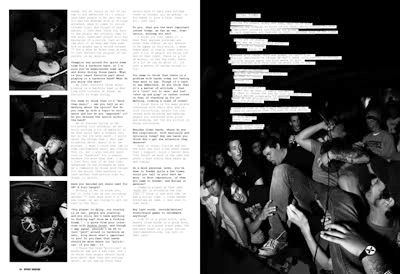
ON spread from Effort Fanzine issue 1
Mindset is my favorite current band. I guess a reason why would be that they really sound like Youth Of Today. However, I'm constantly stoked hearing new stuff from them and seeing how Ev really put time and effort into his lyrics. In the new Effort Zine, we actually have a feature on the new Mindset 7", where Evan gets to elaborate on his ideas presented in the new songs, and I totally connect with the whole vibe Mindset are putting out. From videos I've seen they're a pretty awesome live band as well, so I'm looking forward to seeing them on our continent sometime in the future.
Just yesterday I was visiting Common Cause in the studio when they were recording their new 7", and the stuff I heard there is enough for me to put them on this list. Their previous releases are solid as well, especially the LP, but the new stuff is blowing my mind, and live they just kill it. True Colors have enough releases to speak for themselves, I love that band. Too bad they're breaking up, but I'm really looking forward to that last 7". ON was great when I saw them this summer on their Euro tour, and I like the fact that they're not promoting themselves as an "ex-members of" kinda band. Get The Most is just wild, awesome hardcore. Too bad I couldn't catch them on one of their Euro dates last year. Basically, React! Records - Quality label, with a quality dude behind it.
K: There are a few reasons we do this fanzine together, and to keep it simple you can just ask us about our favorite bands. I wouldn't change a name on that list.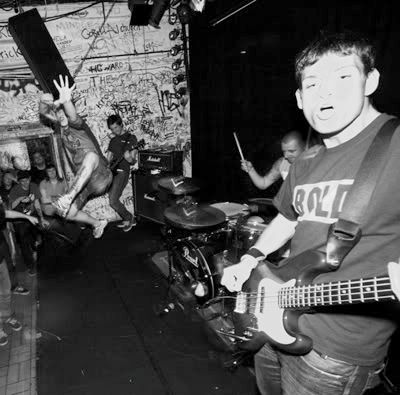
True Colors photo from Effort Fanzine issue 1
What would be the most memorable show you went to and why?
U: Most memorable show for me would have to be the Outlast reunion show in Linköping 2003. If you're not familiar with that band, I'd say that when it comes to Swedish hardcore, we all can pretty much agree on Refused being the big name. In Sweden, Outlast is in that league as well. One of the most important bands for the Swedish hardcore scene, and I never thought I'd see them. That show was really something else. More recently, seeing The First Step was amazing each time, definitely my favorite band of the past decade.
K: The first show that comes to mind is Shelter at Café Eloge in Vänersborg 2001. We skipped school and took a flight there and it was just everything a hardcore show should be. Perfect stage, huge crowd, amazing bands and the support act Subject To Change played "Put It Aside" with Porcell on guitar and Ray on vocals during the mosh. It was almost unreal.
Any final words, plugs, info on where people can order copies of Effort Fanzine?
K: A huge thank you for helping us out, we really appreciate it. It's truly overwhelming to be a part of such an incredible thing as DCXX, considering past features. Also a huge thank you to Aram React! Effort #3 will soon be available through itstimetoreact.com and effortfanzine on myspace. Issue 2 is still available at both React and at Revelation.
U: Thank you for supporting us since the first issue. It's really motivating and rewarding to do a zine when we get all this positive feedback. We're stoked to be on DCXX! Also, thanks to all the bands and people who've been as stoked about being a part of this as we are. Peace.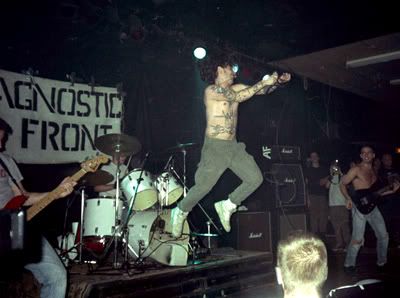
Agnostic Front photo from Effort Fanzine issue 3, Photo: Phillip Fuller
Thursday, February 18, 2010
Dedicated to all the kids who care enough to make tomorrow a brighter day… Let's make a change!
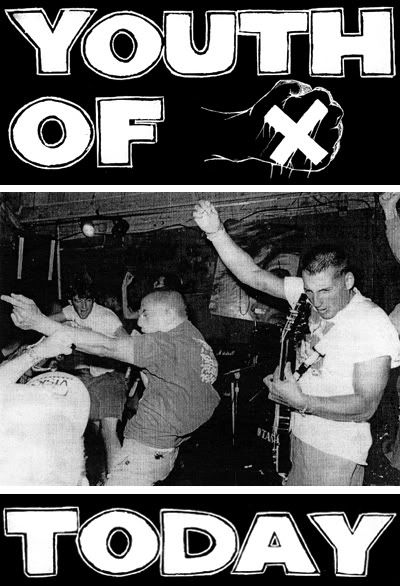
I see it on the streets
As we walk right by
What little value we place on human lives!
But it's time we get priorities
It's time to rearrange
Won't turn away any longer
It's time we make a change!
People so cold
They ignore others' pain
People too proud
To realize that we're the same
But I'll make a change!
But it's time we get priorities
It's time to rearrange
Won't turn my back any longer
It's time we make a change!
Wednesday, February 17, 2010
Matt Henderson - Blind Approach / AF / Madball - PART IV
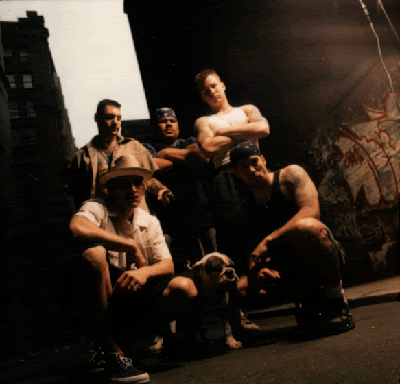
1995 Madball promo test, photo courtesy of: Matt Henderson
If you've been following along, you know this has been a great interview. If not, go check the previous installments. Plenty of AF and Madball talk here. Enjoy. -Gordo DCXX
Relativity Records: It’s a known fact that you guys (AF) weren’t happy with them later on, but at the moment, how was the relationship with the label? What other labels were you guys looking at back then?
When we did that record I didn’t know anything about the business and just thought it was kind of cool to be on a label that could pay for our recording and actually print up CDs, get ads in magazines, etc. Roger really dealt with them as it was his deal long before I got in the band, so that question is better for him to answer. I do remember some good people working with us though that I still talk to today like Bill Wilson (Blackout), Howie Abrams (Madball’s first Road Runner rep) and Brian Freeman. Another thing I remember was that we were the first band that they decided not to release on vinyl, and only on CD. That was a big deal for the hardcore scene to bitch about and we were kinda pissed.
The back ups: Biohazard, Armand, Wrecking Crew: Tell us more about your relationship with those bands/guys.
Armand was really good friends with Craig and was actually working at the label at that time. He is a really good musician and would hang out with us a lot while we worked on the record and was always a good guy to bounce stuff off of. I knew Wrecking Crew pretty well because they did a summer tour in 1988 and when they hit Mpls they had van problems that forced them to stay at one of my friend’s house for a week or so and we hung out a lot then. When I moved to Boston we reconnected and I used to tag along with them when they played shows. So when we did the record in Rhode Island it was an easy trip for them to make and come help out. The rest of the AF guys knew them as well from doing shows together so that was cool.
Biohazard and AF had established a relationship from doing a lot of shows together around then and they were able to make the trip as well. That was one of the better memories I have being in the studio and everybody had a good time. Plus, I think the backups are one of the better sounding things on that record, so thanks to those guys for helping out.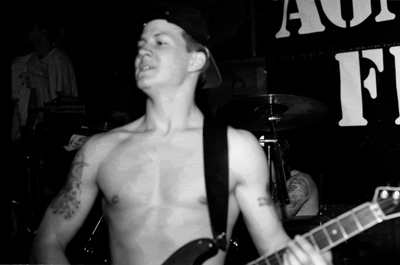
Matt with Agnostic Front in 1992, Photo courtesy of: Matt Henderson
Last Warning: tell us more about that last show at CB’s. What were the other bands like that day? Especially Dmize? Tell us what you remember about that band in general?
That was a good day and a great show. Roger was really intent on getting the right bands to play with, not only to have a good show, but to give the bands he thought deserved the opportunity to play a show at a time when there really wasn’t a lot of shows going on, and to help out friends. It was sort of saying “this is our last show, but everybody needs to realize that these other great bands are out there playing still and need your support." I really liked Dmize. I was just starting to get to know Hoya and he played their latest demo with “Soul Search” for me and I dug it. They also did a cover of Black Sabbath’s “Zero the Hero” which was real cool. The other bands that stood out for me that day were Merauder and Cold As Life – R.I.P Big Rawn.
During Infiltrate, you hear Roger calling out Minus for doing the crucial underwear mosh. Any good stories about Minus? Any other NYHC characters you’d like to reminisce about?
So, yeah, Minus was in his underwear. That was his thing, or at least at about every show I would see him at. My stories about Minus are that he was always a really respectful guy to me and anyone around me, whether he had his pants on or not. As far as other characters in NYC, there are just too many to mention, and most of the rumors you hear about them are all probably true, unless they include random acts of violence toward innocent people. There were acts of violence, but 99.9 percent of the time people were asking for it when it came their way so it wasn’t random and nobody was innocent.
AF played the official last show at CB’s but you guys did a Farewell tour in Europe shortly after, what do you remember of that tour? Europe always had a lot of respect for NYHC bands in general, any opinions on that?
That was a great tour for us, and so much different than that first tour that I mentioned earlier. It made me regret the end of the band a little because the shows were so good. I don’t really know why Europe as a whole is so much more receptive to American/NY Hardcore but clearly it hits a nerve with the people there and I definitely appreciate their support.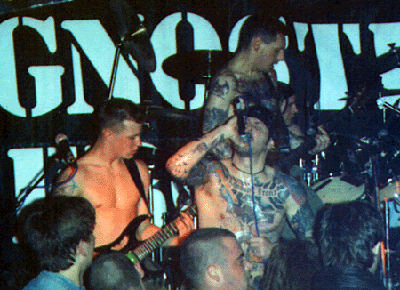
Matt, Roger and Vinny with Agnostic Front, 1992, Photo courtesy of: Matt Henderson
What was your initial reaction when you learned that AF was going to be breaking up? What were your plans then? Madball had already put out something in 89 but when did you join Madball exactly and when were the Droppin’ Many Suckers songs written?
The initial reaction I had was “it's time." I felt like we really put our hearts into what we were doing but we were all a little burnt out and had gone through some rough times for real. One of the smartest things I think Roger did was to encourage us to do a Madball EP and release it for that tour. On our first tour in Europe in 1990 there were a lot of people asking “where’s Freddy Madball??!!” and showing up with the seven inch for signatures, etc., so it was obvious that it made a big impact out there.
And because Freddy was in NYC in 1992 and he would travel with us we thought we could bring him to Europe for that last tour as well. So we put some music together and Freddy wound up using a lot of lyrics out of a notebook of Roger’s with stuff that he had written while he was locked up. I loved writing those songs because it was more simple and straight forward stuff and was nowhere near as technical as the AF songs would get. We recorded at Don Fury’s spot in like 2 days and that was it. We actually played two sets every night on that European tour opening for ourselves as Madball, with Roger on bass and Freddy singing. We would always say shit like, “yo we just want to give a shout out to AF for hooking us up and letting us use their gear for the show”, or “shout out to AF – great guys except for that bass player – he’s a real dick” because Craig was always on the side of the stage and it was fun to break his balls. I don’t know if people got the joke or not but we had a good time with it.
Another Voice: how did you feel about the record? What was your involvement in it? Do you feel like it’s actually another One Voice?
Originally the goal was to get Craig and Willy involved but it just didn’t happen, and without them it is hard for me to consider that record a true continuation of One Voice, but I had a good time with it and I think the record came out good. It was a good opportunity to play guitar again and work with Roger.
What’s the most important thing you learned while playing in AF?
What a good rhythm section is all about. Bass, guitar and drums locking it down. No band should be without it.
What was the best/worst thing about playing with AF?
The best thing was becoming friends with those guys and joining the NYHC family.
The worst thing had nothing to do with the band itself, it just wasn’t a great period for hardcore. People who used to go to AF shows all grew up and started going to school (like me) or started to play in bands that sounded like Quicksand, or Stone Temple Pilots, or some Emo garbage and thought that hardcore wasn’t cool anymore. They changed their minds later on but it took a few years and a few Madball shows to kick them in their asses.
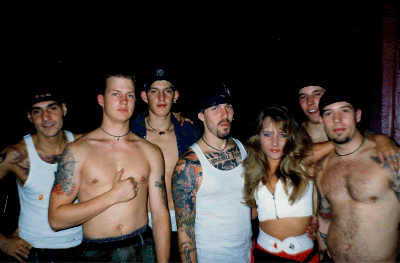
Agnostic Front hang out 1992 on the Obituary tour, Photo courtesy of: Matt Henderson
Tell us about the transition from AF to Madball and about who came up with the idea that Madball should be full-time/serious band?
So after we came back from that European tour and AF was over Roger headed to Miami to become a Harley mechanic and I decided to head back to Boston to finish school because I didn’t have anything else going on in NYC full time. We did have the DMS 7” out though and we figured why not just have fun and play shows on weekends. Hoya was brought in at that time to fill the bass player slot. It was a good reason for me to go to NYC on the weekends and be with my friends and we had good time doing it.
The shows were really small because not much was going on in the city at that time. The goal was not to take it to a “professional level” at all until we got approached by Howie who was at RoadRunner and he wanted to sign us and have us do a full length. I had a hard time deciding if that was really what I wanted to do because of all the shit that AF just went through, but I really liked playing the Madball songs, and once I started playing with Hoya and got a feel for his style – he writes some amazing shit – I thought that it was a good opportunity. For me it was a little like getting a chance to start fresh. Madball already had a name obviously, but they were only known for two EPs, one of which I wrote the majority of the music for, and I wanted to keep going with it musically.
You basically were active during what people often consider the worst years of HC (early/mid 90s to end of 90s). Tell us your take on that era (the rise of vegan straight edge, shitty screamo/political bands): do you feel like it got away from the roots too much? Some great records were written in that era (you guys, Crown Of Thornz, Merauder, Blood for Blood, Breakdown), did anything stand out then that you remember?
I agree that the early 90s were a bad time. That was a backlash to the late 80s peak. 1990 was all about “post-hardcore” with ex-members of well known hardcore bands starting new bands like Quicksand, Fugazi, and Into Another. Some of that music was ok, but I always felt like there was an attitude along with it like “hardcore is over and we are playing real music now.” I didn’t go for that shit so I listened to metal more at that time. Slayer had Seasons In The Abyss which was a great record.
Then there was the beginning of the whole Social Distortion greaser/cowboy fantasy which I really hated. Social Distortion’s first record in 1982 was a great punk rock record, but all of a sudden that “Ball And Chain” shit started and everbody started cuffing their jeans and sticking a big comb in their back pocket and I wanted no part of it. That’s what made being in Madball in 1993/1994 a lot of fun. We were all about “Fuck you. We like playing hardcore.” And we were good at it.
We would play these real small shows back then that were made up mostly of our friends, a lot of whom were done with hardcore but came to our shows because they wanted to see old friends. Eventually, people started digging the music and by 1995 I felt like the scene was thriving again. It was in the city anyway, with a good mix of young blood and the old timers all at the shows. We had Madball, 25 Ta Life, Merauder, Bulldoze, Vision Of Disorder, and H20 all playing shows together. New Jersey had Fury of Five, Boston had 454 Big Block, Blood for Blood, Ten Yard Fight and others. There was Powerhouse and the Hoods on the West Coast, so it felt like a scene to me. The Midwest didn’t have much going on from my memory, but the Northeast and CA were real good.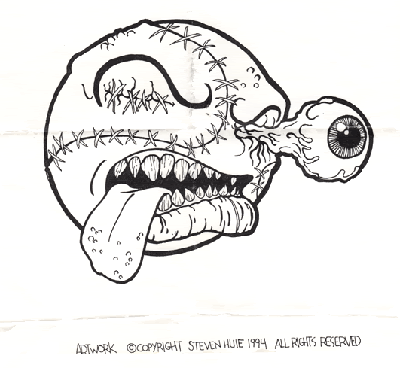
Original artwork for 1994 Madball logo, courtesy of: Matt Henderson
Take us through the Madball discography (favorite song on each album, best/worst thing about each of those records, etc.). Ball Of Destruction: you weren’t on the record but what did you think of that record the first time you heard it?
Fucking great! It was like a continuation of Victim In Pain and hit the nail on the head.
Droppin' Many Suckers: how did you like recording with Don Fury? I still think this is one of the hardest seven inches ever written.
Don Fury, the man, the legend….. I hate the way that recording sounds but I love those songs. I don’t really think that recording does those songs justice. I have a cassette somewhere of us doing those songs live on the radio in Jersey, WSOU, right before we went on that last tour and it sounds amazing. We used to write in this crappy little rehearsal studio in SoHo called Giant and the equipment was shit but it added to the rawness.
We would work on getting our music together and Freddy, who would show up when he got out of high school for the day, would sit in the corner with his book bag and work with Roger’s notebook and add or erase stuff. Then when he said that he had something that might work we would start the song and he would grab the mic and scream and bounce off the walls and those songs totally came to life. Freddy had a lot of anger and energy back then and it all came out real clear.
When we did those songs in Europe people were actually a little afraid of us and especially Freddy. Freddy would just put it right in everybody’s face and people would have to take a few steps back. Good times.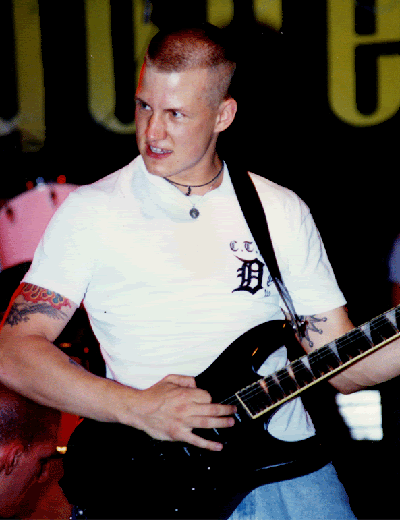
Matt with Madball at the Marquee in 1994, Photo courtesy of: Matt Henderson
How was the relationship with Wreckage Records?
I think it was a win-win for both sides. We did Droppin’ Many Suckers for dirt cheap and I am sure they got their money back and then some. We got a lot of seven inches up front to sell and had no expectations from them beyond that.
Did you even think that some of the songs would stand the test of time they way they did?
I didn’t really think about it that way. I was just looking to have fun playing some straight up hardcore with my friends.
Set It Off: one of the 3 most important records of the 90s.
This is when I feel we really started to become a true band. I really enjoyed writing music with Hoya because his style had such a groove and he would write these riffs that would force me to step it up as well. I remember being in Boston and I called him up to check in and he was like “yo, I think I got a new song for the record,” and he played the opening riff to Set It Off over the phone with his cheap guitar and shitty little practice amp in his bedroom and I was blown away. That was the start of the transition from the Ball of Destruction/DMS real raw style to the more groove-oriented stuff that I really liked about Madball.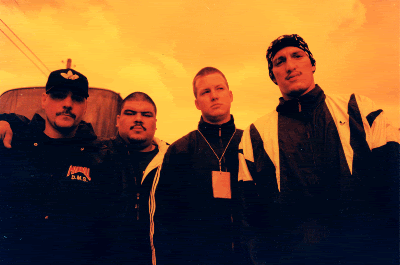
Madball in Belgium, 1996, Photo courtesy of: Matt Henderson
What do you remember the response/reaction to it in the scene?
Once again, I didn’t feel like people were getting what we were doing right away. I remember doing the song Set It Off for the first time live before the record came out and people just stood there and looked at us. I don’t really know why. I remember heading to Argentina right after the record came out – we had connections there from the AF days, and we played it for some friends that were AF fans and they would say “its really interesting…..? Aside from Sick of It All, who were on the road a lot and didn’t play NYC much at that time, I felt like we were the only ones trying to do real, mean, tough, hardcore. I think it took people a minute to figure it out.
Tell us about being on Roadrunner.
Being on RoadRunner was cool and that label was really good to us. They had their office just a few blocks away from Vinny’s apartment and we would just show up there all the time and bullshit with everyone. I know all of the DIY people think we were on some big metal label and it probably turned some people off, but that label and the people who were a part of it were very down to earth, knew the scene, loved heavy music and believed in what we were trying to do.
Now, they are a business so of course they did what they could to make their money but what fucking label doesn’t? I can guarantee that the more trendy labels that are popular in hardcore are the same way, so don’t be fooled. If you really think that other labels are more interested in the artists and are more grass roots, you are confused. More bands get ripped off by “friends” or “indie” labels than labels with contracts and lawyers. 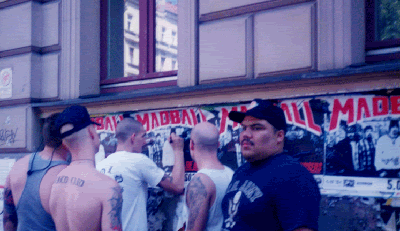
Madball in Europe drawing beards on their own promo posters, Photo courtesy of: Matt Henderson

